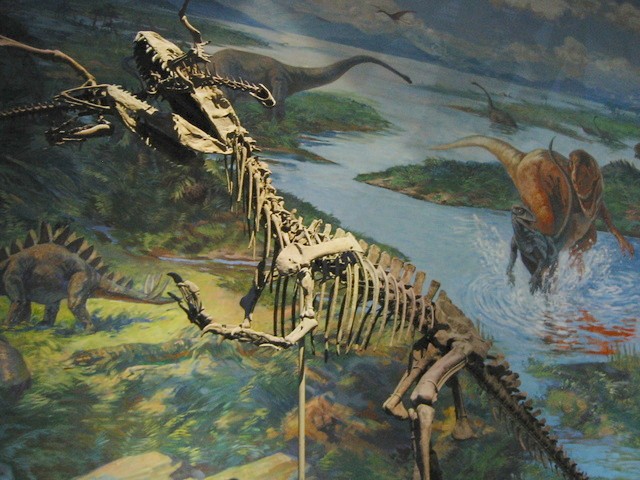Zigong Dinosaur Museum on:
[Wikipedia]
[Google]
[Amazon]




 The Zigong Dinosaur Museum () is located near the city of
The Zigong Dinosaur Museum () is located near the city of




Zigong
Zigong (, ), formed by the merger of the two former towns of Ziliujing (Tzuliuching, literally "self-flow well") and Gongjing (Kungching, literally "offering well"), is a prefecture-level city in Sichuan, southwestern China.
Demographics
Accord ...
, Sichuan
Sichuan (; zh, c=, labels=no, ; zh, p=Sìchuān; alternatively romanized as Szechuan or Szechwan; formerly also referred to as "West China" or "Western China" by Protestant missions) is a province in Southwest China occupying most of the ...
, China
China, officially the People's Republic of China (PRC), is a country in East Asia. It is the world's most populous country, with a population exceeding 1.4 billion, slightly ahead of India. China spans the equivalent of five time zones and ...
, in the township of Dashanpu
The Shaximiao Formation () is a Middle to Late Jurassic aged geological formation in Sichuan, China, most notable for the wealth of dinosaurs fossils that have been excavated from its strata. The Shaximiao Formation is exposed in and around th ...
.
History
The museum sits on top of a large concentration of a diversedinosaur
Dinosaurs are a diverse group of reptiles of the clade Dinosauria. They first appeared during the Triassic period, between 243 and 233.23 million years ago (mya), although the exact origin and timing of the evolution of dinosaurs is t ...
assemblage from the Shaximiao Formation
The Shaximiao Formation () is a Middle Jurassic, Middle to Late Jurassic aged geological formation in Sichuan, China, most notable for the wealth of dinosaurs fossils that have been excavated from its strata. The Shaximiao Formation is exposed in ...
. The museum claims the largest number of dinosaur fossils in the world and covers 25,000 square meters with a display area of 3,600 square meters. It attracts up to seven million visitors a year.
In 1980s, vast quantities of dinosaur fossils were excavated in the Middle Jurassic Shaximiao Formation
The Shaximiao Formation () is a Middle Jurassic, Middle to Late Jurassic aged geological formation in Sichuan, China, most notable for the wealth of dinosaurs fossils that have been excavated from its strata. The Shaximiao Formation is exposed in ...
, 7 km north-east from downtown Zigong, including a dinosaur named after the township, ''Dashanpusaurus
''Dashanpusaurus'' (meaning "Dashanpu lizard" after the township it was discovered in) is an extinct genus of sauropod dinosaur that lived during the middle of the Jurassic period. The dinosaur was described in 2005 by Peng Guangzhao, Ye Yong, G ...
''. Because of the unique and articulated (intact) bone remains, Zigong is important to paleontologist
Paleontology (), also spelled palaeontology or palæontology, is the scientific study of life that existed prior to, and sometimes including, the start of the Holocene epoch (roughly 11,700 years before present). It includes the study of fossi ...
s and dinosaur
Dinosaurs are a diverse group of reptiles of the clade Dinosauria. They first appeared during the Triassic period, between 243 and 233.23 million years ago (mya), although the exact origin and timing of the evolution of dinosaurs is t ...
enthusiasts. The Zigong Dinosaur Museum was established in 1987, becoming the first museum based almost entirely on dinosaurs in Asia. Mounted specimens include ''Omeisaurus
''Omeisaurus'' (meaning "Omei lizard") is a genus of sauropod dinosaur from the Middle Jurassic Period (Bathonian-Callovian stage) of what is now China. Its name comes from Mount Emei, where it was discovered in the lower Shaximiao Formation o ...
'', '' Gigantspinosaurus'', ''Yangchuanosaurus
''Yangchuanosaurus'' is an extinct genus of metriacanthosaurid theropod dinosaur that lived in China from the Middle to Late Jurassic periods (Bathonian to Oxfordian stages), and was similar in size and appearance to its North American and Eu ...
'', ''Huayangosaurus
''Huayangosaurus'' is a genus of stegosaurian dinosaur from the Middle Jurassic of China. The name derives from "Huayang" (華陽), an alternate name for Sichuan (the province where it was discovered), and "saurus", meaning "lizard". It lived ...
'' and ''Xiaosaurus
''Xiaosaurus'' ("dawn lizard", ), is a genus of small herbivorous dinosaur from the middle Jurassic, approximately 169 to 163.5 mya. ''Xiaosaurus'' lived in what is now the Sichuan Basin of China.
Discovery and naming
In 1979 and 1980, tw ...
''.
See also
*List of museums in China
, there are 3,589 museums in China, including 3,054 state-owned museums (museums run by national and local government or universities) and 535 private museums. With a total collection of over 20 million items, these museums hold more than 8,000 e ...
References
Dinosaur museums in China Museums in Sichuan Museums established in 1987 1987 establishments in China Zigong National first-grade museums of China {{PRChina-museum-stub